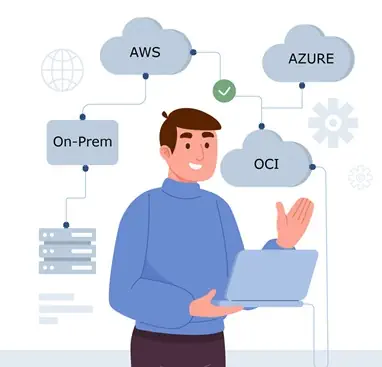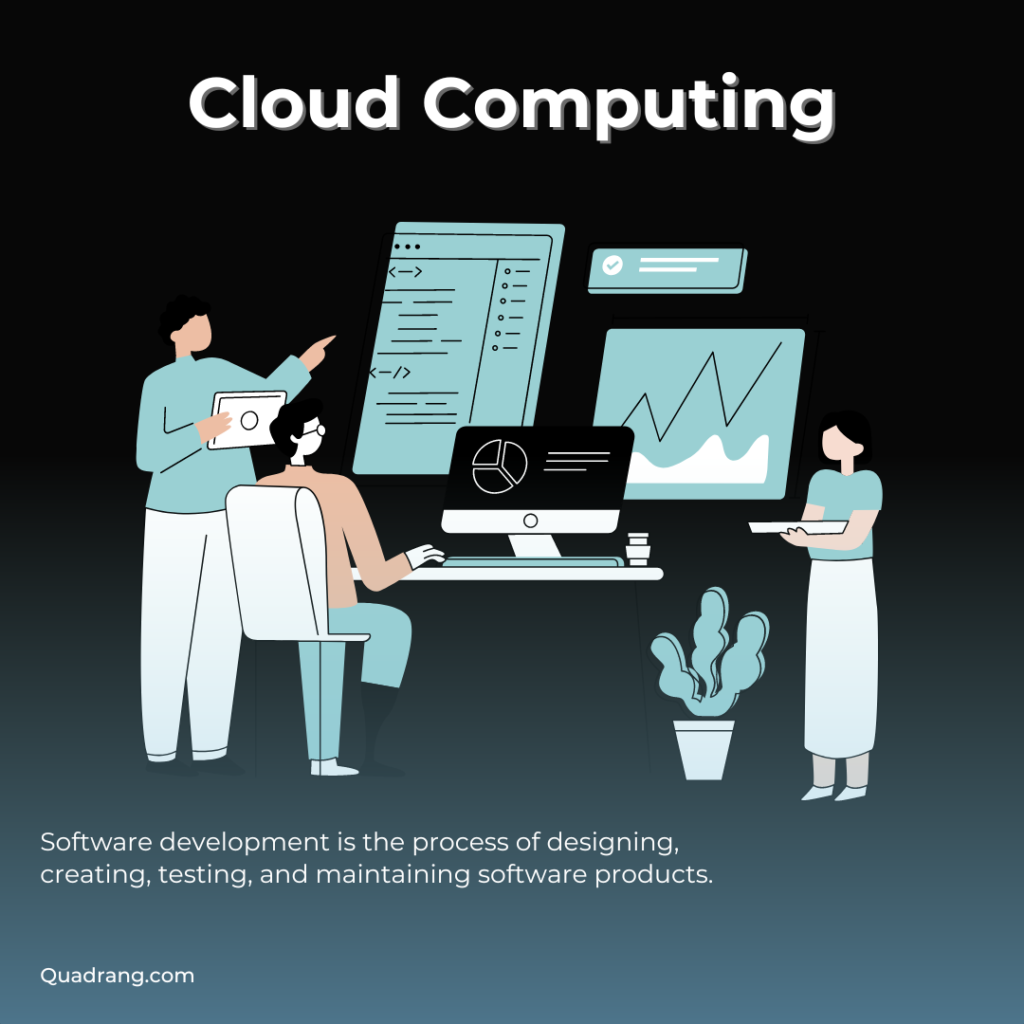Cloud, Infra and DevOps Services
Cloud and On-premise Deployment
- Provision and Administer on-premise and Cloud infrastructure
- Support on popular cloud platforms like AWS, Azure, GCP, DO
- Kubernetes Cluster creation, Administration
- On-prem to Cloud migration
- Manual and automated deployment (IAAC tools)
- Public cloud resource and cost optimization

What Is Cloud Computing ?
Processing, storing, and managing data on a network of distant computers hosted on the internet, as opposed to a local server or personal computer, is known as cloud computing. In specifically, it alludes to a shared storage space where data can be accessed simultaneously by all network devices. Cloud computing offers more efficient and faster ways to adapt and run business operations according to changing industry environments.
Cloud-managed networking is widely adopted by organizations to manage their network infrastructure including wired network, Wi-Fi, and SD-WAN, over a cloud-based service model. The networking service is generally hosted by third parties usually as paid or subscription-based models.
Cloud computing is a method of delivering IT services where software tools and computer resources are supplied via the internet by outside service providers. Under this service model, the user only pays for the amount of time they spend on the computer and the amount of bandwidth and storage they use. Cloud services are utilized by users to store confidential information about their personal and corporate activities on cloud-based systems. However, it is anticipated that issues with data security and privacy, data loss, data breaches, unforeseen crises, application vulnerabilities, and online cyberattacks would impede the development of cloud computing.
Although cloud services help organizations save expenses and boost productivity, data stored in the cloud is susceptible to cyberattacks. Cyberattacks that disclose enterprise data vulnerabilities, such as cloud malware injection, meltdown, account or service hijacking, and man-in-the-cloud assaults, have the potential to cause business closure and losses as well as impede market expansion
Cloud computing provides quicker and more effective means for businesses to adjust and conduct operations in response to shifting industry conditions. It simplifies technology’s consumerization. It has opened up previously unheard-of opportunities to produce incredibly captivating consumer experiences. The cloud has changed how people and corporations behave, allowing different business lines to get things done by getting around tech policies. In essence, cloud trends direct an organization’s vendors, stake holders and technology choices, digital business decision-making processes, and investment strategies.
Cloud Computing Future Opportunites:
For the foreseeable future, cloud computing will continue to significantly transform information technology. Leveraging cutting edge innovations becomes easier as value-added cloud managed and cloud native service ecosystems expand. Because serverless computing hides infrastructure administration responsibilities, it lessens the load of coding. Building complex applications is made easier by containers, which encapsulate complexity into manageable virtual packages.
The capacity to solve problems is greatly increased by machine learning and artificial intelligence, which automatically uncover patterns in data that were previously incomprehensible to humans. Natural language processing-powered conversational interfaces enable communication using voice commands instead of keyboard and screen. Visualization is submerged in dynamic modelling of past, present, or entirely imagined realities through augmented and virtual reality.
As we transition from fixed assets to metered utilities, the cloud becomes a computer. Using on-demand use, which scales elastically and transparently to the workload, levels out the fluctuations in computing requirements over time. Through enormous multi-tenant resource pooling and workload optimization, hyper-scale efficiencies save expenses. Operating costs replace capital expenses, giving IT greater agility and responsiveness. When limitations that limit change across proprietary technology stacks are removed, innovation soars. The cloud represents the bright future of computers.
Benefits Of Cloud Computing
Cost Management: When data is stored in the cloud, users can access it using any device and any location as long as they have an internet connection. This implies that consumers can access their data without carrying around many CDs, USB drives, or external hard disks. Remote workers can stay in touch with clients and co-workers by using smartphones and other mobile devices to access company data. Resources in the cloud are simple for end users to process, save, retrieve, and recover. Additionally, cloud providers save time and labour by automatically providing all upgrades and updates.
Speed: Because the majority of cloud computing services are self-service and on-demand, even enormous amounts of computing power can be made available in a matter of minutes, usually with only a few mouse clicks. This flexibility allows businesses to relieve some of the burden associated with capacity planning.
Performance: Cloud customers benefit from automatically having the latest innovations and emerging technologies built into their IT systems, because the cloud provider takes on the work of developing new capabilities, opportunities and features. better cost price/performance for cloud native workloads. Access to high-performance computing resources is provided by cloud providers, enabling businesses to effectively run complicated programs and handle massive information.
DevOps
- Build, Test, Deliver, Release, Monitor, Repeat
- Focus on automation via tools and scripts
CI/CD & Release management from SCM repo - Containerization and K8S clustering
- Kubernetes Administration
- Site Reliability engineering

What Is DevOps ?
Software development and IT operations are combined through the use of a set of techniques called DevOps. Its objectives are to supply high-quality software continuously and to shorten the systems development life cycle.
DevOps and Agile software development go hand in hand, and many aspects of DevOps are inspired by the Agile methodology. Because of the increased frequency and tempo of releases, it facilitates innovation and development more quickly. They can also fix bugs, add new features, and reply to customer demands considerably faster thanks to it. DevOps techniques like continuous integration and continuous delivery automate the software release process from development to deployment.
The IT processes have become more difficult due to an increasingly sophisticated IT architecture that combines a physical, virtual, and cloud environment. DevOps enters the scene in this situation by using automation to take significant management tasks out of the hands of humans.
This is one of the reasons why, when selecting cloud hosting for their workloads, the enterprises want to build a high degree of DevOps automation and advanced container orchestration. The speed at which a corporation can produce applications and give clients better services is aided by development and operations. Performance in Software Deployment Operations (SDO) is a critical differentiator and facilitator for teams and companies across a wide range of industries.
DevOps is challenging, and some of its complexity necessitates a platform that runs on top of many cloud providers, is both SaaS and managed environments, and possibly also on-premises. There are other difficulties with DevOps as well. AWS, Google Cloud Platform, Microsoft Azure, and Rack space are just a few of the numerous cloud services available, in addition to the staggering variety of physical devices.
DevOps Future Opportunities:
greater application of ML and AI. Processes like testing, infrastructure provisioning, deployment, monitoring, and incident remediation will become even more automated and improved with the use of artificial intelligence and machine learning. It’s possible that AI agents will eventually merge into agile teams.
Site reliability engineering (SRE) is growing. SRE originated at Google with the goal of integrating software engineering concepts into IT system management and operations. Complexity in applications and infrastructure will increase demand for SRE capabilities.
capacity expansion for DevOps. Rather than being used alone, security procedures will become more and more incorporated into DevOps workflows. Teams will be able to work more quickly while lowering risk thanks to security automation, infrastructure as code security, and more intelligent policy controls.
adoption of hybrid and multi-cloud computing. Application portability across public, private, and hybrid clouds will be made easier by supporting technologies like DevOps for container orchestration. This is essential for resilience and avoiding vendor lock-in.
Leverage of the platform is increased. Containers, serverless computing, and other cloud-native technologies will reduce the need for operations maintenance while enabling developers to create and deliver innovations more quickly.
Benefits Of DevOps Industry:
Faster, better product delivery: The overall increase in agility and efficiency in both proactive and reactive reactions to business requirements is one of the benefits of DevOps for businesses. In all honesty, agility seems like a necessary business requirement in this day and age if one was going to survive upheaval and eventual collapse. A few days earlier rollout of an upgrade release could mean the difference between success and failure.
For this reason, DevOps has a significant advantage in the present business environment. The only viable approach is a quicker response more often, which is made feasible by DevOps and adaptive IT’s agility and modularity
Faster issue resolution and reduced complexity: Automate known-issue remediation processes by utilizing runbooks and self-healing features. Only when abnormalities continue may humans intervene.
By using policy-driven orchestration and infrastructure-as-code, configuration concerns can be abstracted. It is advised to use immutable infrastructure patterns. To swiftly highlight actionable findings, make use of AI Ops solutions that include automation, machine learning, and sophisticated analytics.
Greater scalability and availability: IaC make it possible to provision and manage infrastructure programmatically. This makes it possible for teams to adjust their resource levels in response to demand, guaranteeing that the infrastructure can readily adjust to changing workloads.
Applications / Softwares and their dependencies of be packaged in a lightweight, easy to handle, portable manner with containers. Applications that are containerized can be automatically scaled in response to demand thanks to container orchestration solutions like Kubernetes.
